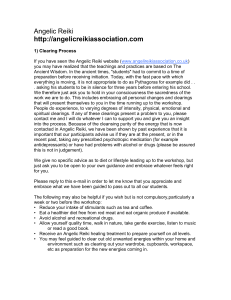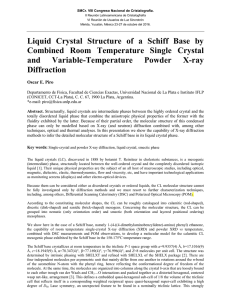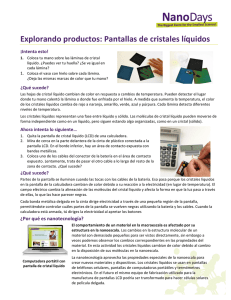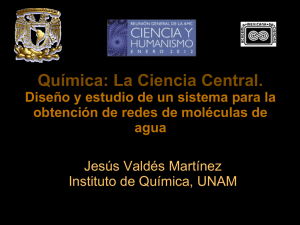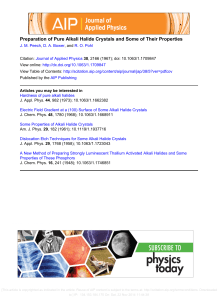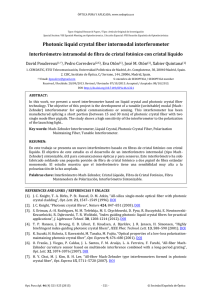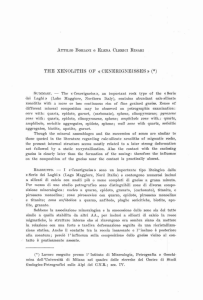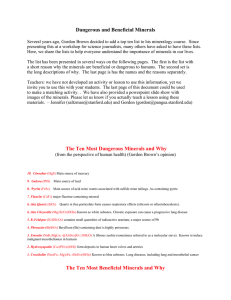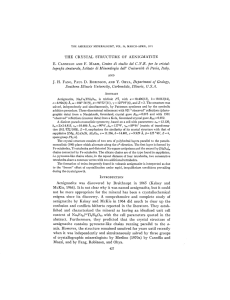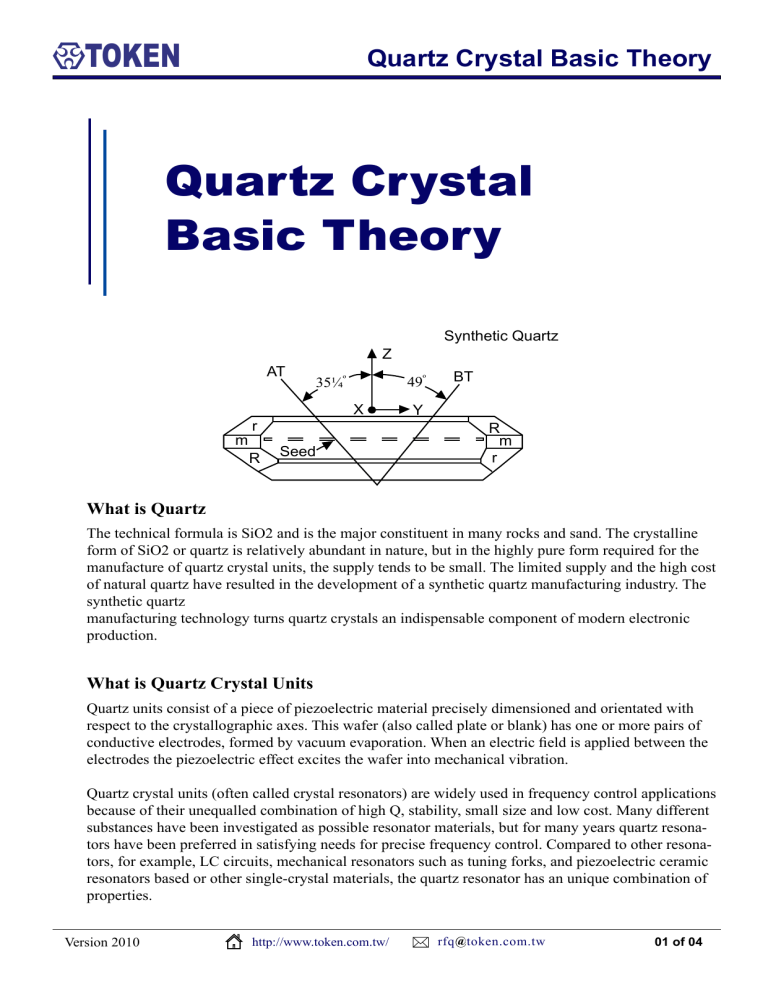
TOKEN Quartz Crystal Basic Theory Quartz Crystal Basic Theory AT m 49º 35¼º X r R Synthetic Quartz Z Seed Y BT R m r What is Quartz The technical formula is SiO2 and is the major constituent in many rocks and sand. The crystalline form of SiO2 or quartz is relatively abundant in nature, but in the highly pure form required for the manufacture of quartz crystal units, the supply tends to be small. The limited supply and the high cost of natural quartz have resulted in the development of a synthetic quartz manufacturing industry. The synthetic quartz manufacturing technology turns quartz crystals an indispensable component of modern electronic production. What is Quartz Crystal Units Quartz units consist of a piece of piezoelectric material precisely dimensioned and orientated with respect to the crystallographic axes. This wafer (also called plate or blank) has one or more pairs of conductive electrodes, formed by vacuum evaporation. When an electric field is applied between the electrodes the piezoelectric effect excites the wafer into mechanical vibration. Quartz crystal units (often called crystal resonators) are widely used in frequency control applications because of their unequalled combination of high Q, stability, small size and low cost. Many different substances have been investigated as possible resonator materials, but for many years quartz resonators have been preferred in satisfying needs for precise frequency control. Compared to other resonators, for example, LC circuits, mechanical resonators such as tuning forks, and piezoelectric ceramic resonators based or other single-crystal materials, the quartz resonator has an unique combination of properties. Version 2010 http://www.token.com.tw/ rfq token.com.tw 01 of 04 TOKEN Quartz Crystal Basic Theory Flexure Mode Length Extensional Mode Face Shear Mode ThickNess Shear Mode Fundamental Mode (Thickness Shear) Third Overtone Mode (Thickness) First, the material properties of single-crystal quartz are extremely stable with time, temperature, and other environmental changes, as well as highly repeatable from one specimen to another. The acoustic loss or internal friction of quartz is very low, which results in a quartz resonator having an extremely high Q-factor. The intrinsic Q of quartz is about 107 at 1 MHz. Mounted resonators typically have Q factors ranging from tens of thousands to several hundred thousand, which is orders of magnitude better than the best LC circuits. The second key property of the quartz resonator is its stability with respect to temperature variation. Depending on the shape and orientation of the crystal blank, many different modes of vibration can be used and it is possible to control the frequency-temperature characteristics of the quartz resonator to within close limits by an appropriate choice. The most commonly used type of resonator is the AT-cut, where the quartz blank is in the form of thin plate cut as an angle of about 35°15’ to the optic axis of the crystal. The third essential characteristic of the quartz resonator is related to the stability of its mechanical properties. Short and long term stabilities manifested in frequency drifts of only a few parts per million per year are readily available from commercial units. Precision crystal units manufactured under closely controlled conditions are second only to atomic clocks in the frequency stability and precision achieved. 02 of 04 http://www.token.com.tw/ rfq token.com.tw Version 2010 TOKEN Quartz Crystal Basic Theory How Piezoelectricity Works for Quartz Unit The word piezo-electricity takes its name from the Greek piezein “to press”, which literally means pressure electricity. Certain classes of piezoelectric materials will in general react to any mechanical stresses by producing an electrical charge. In a piezoelectric medium the strain or the displacement depends linearly on both the stress and the field. The converse effect also exists, whereby a mechanical strain is produced in the crystal by a polarising electric field. This is the basic effect which produces the vibration of a quartz crystal. What Makes Optimal Angle of Cut So Important The right schematic diagram (Figure-1) is a cultured quartz crystal grown from a Y-oriented seed crystal for use in fabricating AT-cut resonators. A seed crystal establishes the initial crystal orientation and encourages growth in the Y direction at the expense of the Z-axis. Seed crystals are carefully selected by Token to avoid defects which might propagate as the crystal grows. The position of the seed crystal is indicated. The lines sloping left from the x-axis mark the saw cut position for AT plates, the line sloping to the right indicates the BT-cut. In practice, these angles are very critical and are precisely determined using Bragg diffraction (also referred to as the Bragg formulation of X-ray diffraction). The AT-cut characteristic is the most commonly used type of resonator. It has a frequency temperature coefficient described by a cubic function of temperature, which can be precisely controlled by small variations in the angle of cut. This cubic behaviour is in contrast to most other crystal cuts which give a parabolic temperature characteristic. It makes the AT-cut well suited to applications requiring a high degree of frequency stability over wide temperature ranges. Other important characteristics are aging and quality factor Q. Vibration Modes The AT-cut resonator uses the thickness shear mode of vibration (Figure-2). A standing wave is set up in the crystal blank by the reflection at both major surfaces of traverse waves travelling in the thickness direction. The major mechanical displacement is in the plane of the crystal at right angles to the direction of wave propagation. At resonance an odd number of half wave lengths are contained in the thickness plane of the crystal blank. Therefore the thickness is the primary frequency determining dimension. The AT-cut is commonly manufactured in the frequency ranges: 1 MHz ~ 32 MHz as Fundamental Mode 30 MHz ~ 250 MHz as Overtone Mode (3rd; 5th; 7th; 9th) Below about 1 MHz the thickness shear mode resonators become too cumbersome and clumsy for general use and other modes of vibrations are used: below about 100 KHz Flexural Mode, Length Extensional Mode 100 KHz Face Shear Mode (CT-Cut; DT-Cut; SL-Cut) For each mode of vibration there is an optimal angle of cut which controls the frequency deviation of the quartz crystal over the temperature range. Version 2010 http://www.token.com.tw/ rfq token.com.tw 03 of 04 TOKEN Quartz Crystal Basic Theory Glossary & Terminology Aging The frequency change of the crystal operated at specific conditions for a certain period of time. AT-Cut A crystal cut, which the orientation of a synthetic quartz bar is set up at 35°15’ from the Z axis and its temperature characteristics show a cubic curve. The mode of vibration is thickness-shear. Autoclave A sealed vessel made from special iron, that withstands high pressure and heat. Base-Plating A process of applying coatings of metal layers on the surface of crystal wafers. There are two main methods: vacuum deposition and sputtering. The vacuum deposition melts metals in the chambers under a vacuum state. The sputtering method occurs by bombarding the surface of the sputtering target with gaseous ions. BT-Cut A crystal cut, which the orientation of a synthetic quartz bar is set up at -49° from the Z axis and its temperature characteristics show a turnover curve. The mode of vibration is thickness-shear. Bypass Capacitor A component required to lower the impedance of the power-supply system inserted between the power-supply pin and ground pin of the IC. Mount as closely as possible to the IC, using a bypass capacitor with a capacitance suitable for the oscillation frequency. (Example) KHz range 10μF to 100μF MHz range: 0.01μF to 0.1μF Crystal Resonators with Suppressed Fundamental Mode The crystals with suppressed fundamental mode are designed to suppress the fundamental oscilla tion of third overtone resonators to ensure proper overtone oscillation. These crystals enable the oscillation of overtone frequencies on a circuit without using a tuning coil. This has the benefi cial effects of reducing the number of components in the circuit, reducing the need for trimming and miniaturization. Equivalent Circuit The electrical equivalent circuit of a crystal resonator operating at its mechanical resonant frequency. Frequency The number of recurrences of a periodic phenomenon (like radio wave or acoustic wave) per one second, often measured in Hertz (Hz). 04 of 04 http://www.token.com.tw/ rfq token.com.tw Version 2010
